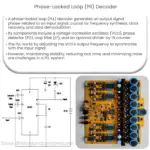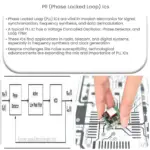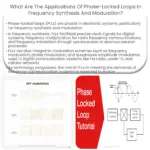A phase-locked loop (PLL) is a feedback control system that generates an output signal with a phase related to an input signal, used in frequency synthesis and clock recovery.
Introduction to Phase-Locked Loop (PLL)
A phase-locked loop (PLL) is a feedback control system that generates an output signal whose phase is related to the phase of an input signal. PLLs are widely used in frequency and phase control applications such as frequency synthesis, clock and data recovery, and frequency modulation (FM) and demodulation.
Components of a PLL
A typical PLL consists of three main components:
- Phase detector (PD): The PD compares the phase of the input signal and the output signal of the VCO, generating an error signal proportional to their phase difference.
- Low-pass filter (LPF): The LPF removes high-frequency noise from the error signal, producing a smooth control voltage for the VCO.
- Voltage-controlled oscillator (VCO): The VCO generates an output signal whose frequency is controlled by the input control voltage. The output frequency increases or decreases depending on the input voltage.
How a PLL Works
In a PLL, the phase detector compares the phase of the input signal (also called the reference signal) with the phase of the output signal from the VCO. If there is a phase difference between the input and output signals, the phase detector generates an error voltage proportional to the phase difference. This error voltage is filtered by the low-pass filter to remove high-frequency noise, and the resulting control voltage is applied to the VCO.
The VCO adjusts its output frequency based on the control voltage. If the output frequency is too low, the control voltage increases, causing the VCO to increase its output frequency. Conversely, if the output frequency is too high, the control voltage decreases, causing the VCO to decrease its output frequency. This process continues until the output frequency is locked to the input frequency, and the phase difference is minimized.
Applications of PLLs
PLLs are used in a wide range of applications, such as:
- Frequency synthesis: PLLs can generate a stable output frequency that is a multiple of the input reference frequency, making them essential in communication systems and signal processing.
- Clock and data recovery: In digital communication systems, PLLs are used to recover the clock signal embedded in the received data and to regenerate a clean, synchronized data stream.
- Frequency modulation and demodulation: PLLs can be used as both FM modulators and demodulators, providing a simple and efficient method for transmitting and receiving information.
- Jitter reduction: PLLs can reduce jitter in digital systems by locking onto a stable reference clock signal and filtering out high-frequency noise.
.png)




